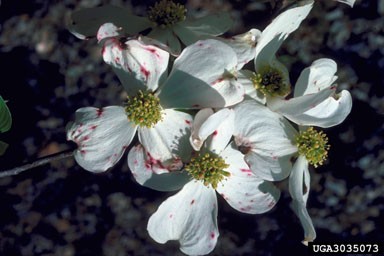Anthracnose
Anthracnose is a general term for a group of diseases on hardwoods that cause lesions on leaves, twigs, and fruits. Generally, these diseases are cosmetic and cause no serious damage to the tree (but there are some exceptions). There are many species of fungi known to cause anthracnose, but most only infect one or a few specific host species. Therefore, these diseases are named for the tree species on which they may be found. For example, some include sycamore anthracnose, oak anthracnose, maple anthracnose, and dogwood spot anthracnose. Disease cycles and control strategies are similar regardless of the causal organism; therefore specific identification of the fungal species is not usually necessary. Dogwood anthracnose (not to be confused with dogwood spot anthracnose) is a serious disease of dogwood, and most often results in the death of the host; the following information does not apply to dogwood anthracnose.

Symptoms vary with species, but in general the most obvious symptoms are the leaf lesions produced in the spring and expand throughout the summer. Lesions often begin as pale green or greenish-grey blotches, but then turn yellow, tan, reddish-brown, or brown. Often lesions have a distinct, colorful margin. Lesions tend to begin along leaf veins (because the depressions along veins hold water for a longer period of time and spores tend to collect there), but often rapidly expand. Expansion often follows the soft tissues adjacent to veins, and may result in the coalescing of many lesions. Severely infected leaves may have a scorched appearance, becoming almost completely brown, wilted, or cupped. (Note: drought symptoms and/or leaf scorch differ because the browning and wilting of leaf tissue begins at the leaf tips and leaf margins and progresses inward). Some trees respond to infection by prematurely shedding leaves (e.g. sycamore and ash), but others retain their leaves until normal leaf drop in the fall (e.g. oak). In sycamore, the fungus is able to grow out of leaves into adjacent twigs where it causes small cankers, shoot dieback, witches brooms, and/or deformed twigs.
No formal survey for anthracnose exists in Tennessee. Forestry personnel are trained to recognized signs and symptoms of the disease and work with forest landowners to educate them on ways to maintain their trees and make sound decisions regarding tree selection and planting sites.

Management for anthracnose is usually not necessary as it causes no serious harm to the tree; however, aesthetic concerns may warrant an attempt to reduce disease severity. Plant trees on a wide spacing, keep the surrounding area clear of vegetation, and prune properly to improve air circulation within the crown. Raking and destruction of leaves in the fall is often very effective in reducing disease incidence the following spring. Fungicides are available for small ornamentals and shade trees.
What Can You Do?
Keep existing trees healthy by pruning trunk sprouts, mulch around the base, water during dry periods, and consistent monitoring. Learn to recognize what the signs and symptoms are of an infestation and immediately contact your county agent or professional forester.
